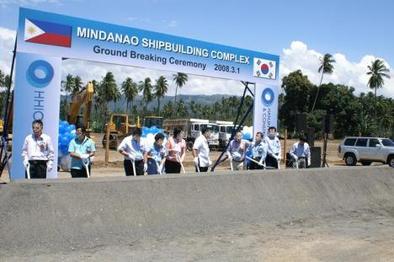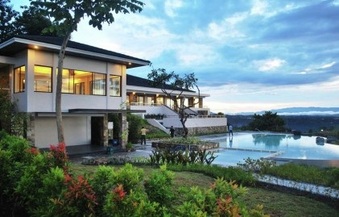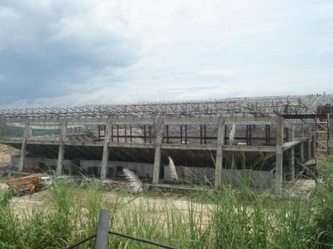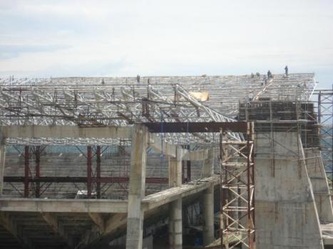READ MORE HERE.
Cagayan de Oro Real Estate l House & Lot For Sale l Philippines
Region 10 has become the largest economy in Mindanao contributing about 28 percent to the annual gross domestic product of the island.
READ MORE HERE.
0 Comments
The Philippines and the Republic of Korea (ROK) signed today a loan arrangement for the Laguindingan Airport Air-Navigation System and Support Facilities Supply Project in ceremonies held at the Department of Foreign Affairs (DFA). Signing for both countries were Foreign Affairs Secretary Albert F. del Rosario (right) and ROK Ambassador to the Philippines Lee Hye-min (left). The event was witnessed by officials from the DFA, the Department of Transportation and Communications and the ROK Embassy.
READ MORE HERE.  Whether this city’s name comes from the Malayo-Polynesian word ag (water) or from the ancient local word karayan (river), locals takes pride in having Cagayan de Oro River or as some would describe it, river of gold. And indeed, even centuries after early gold mining activities in the area by Spanish explorers, the river continues to provide livelihood to the communities where it flows.
Whitewater rafting, for instance, started here as a hobby for a group of outdoor sports enthusiasts. This pastime for adventure seekers now directly employs hundreds and provides income indirectly to probably a thousand more. Among the pioneers in this hobby-turned-business enterprise is Rupert M. Domingo of the Cagayan de Oro Whitewater Rafting Adventure that initially organized group trips to popularize this activity. Consequently, it grew into a thriving business attracting other entrepreneurs before being aggressively promoted by the government’s Tourism department. Having the distinction of being the pioneer rafting outfitter in the city, the Cagayan de Oro Whitewater Rafting Adventure, now known as Rafting Adventure Philippines (RAP), targeted a bigger market. Its leaders, who eventually became investors, painstakingly surveyed the river and perfected the taming of the wild rapids in the river’s head waters. RAP started with only a couple of rafts and one guide. Today, it rents out 22 rafts with 30 guides and paddlers. It holds certifications from the International Rafting Federation for safety and river handling techniques as well as from the Philippine National Red Cross on the application of first-aid and cardiopulmonary resuscitation. Business was good for years until two years ago when rogue Moro rebel units attacked civilian communities in nearby Lanao del Norte, less than two hours away from this city. Tourists arriving in Northern Mindanao dropped significantly and with it, the number of whitewater rafting guests even as new outfitters opened businesses in the city. “I don’t worry too much because we already have a name in the rafting industry,” Mr. Domingo said. “We are not new to this situation anymore.” The industry has been recovering since last year, although actual figures in number of guests as well as revenues were unavailable. Unaffected by the drought that caused problems on the island’s power supply and agriculture in the first six months of the year, the whitewater rafting industry did well with its peak season running from December to May. Another entrepreneur from a relatively newer whitewater rafting firm said that even as the rapids may not be as strong as the normal runs during the dry spell, the river never really slacks. “Our well-trained guides know how to maneuver the rafts so that even if there are few rapids, they make sure they’ll hit the big and exciting drops,” said Roldan Kaamiño, owner of Kagay Whitewater Rafting. “Guests would get bored without those exciting plunges,” he said. Kagay, like the bigger groups into this business, also actively takes part in the protection of the river even as some of its river guides used to be into illegal logging. Part of its briefing before trips is an orientation on the rivers in Lanao provinces and in Bukidnon that all connect to the Cagayan de Oro River. “We document illegal cutting of trees if we chance on these and send reports to the DENR [Department of Environment and Natural Resources] and the local media,” said Mr. Kaamiño. The age-old adage that “water is life” has gone beyond its traditional meaning in this city notwithstanding previous experiences where flash floods destroyed houses built along the banks of Cagayan de Oro river. With six rafting outfitters registered with the City Tourism Office, whitewater rafting is a source of income for many families. SEE RELATED POST article by Louise G. Dumas of Business World Property business in this city has bounced back after experiencing slow-moving inventories two years ago. Alegria Hills, Ayala Land, Inc.’s first residential project in Northern Mindanao, is now 64% sold, with major facilities of the subdivision already completed.
Medium-rise residential structures are also being constructed in various parts of the city, even as shopping malls are expanding in response to increasing consumer expenditures. The situation is in stark contrast to that of two years ago when the global economic crisis halted property development in the region. Upscale projects were almost at a standstill back then until the industries started their recovery last year. Revenues in 2009 for Ayala Land Visayas-Mindanao operations went up 53% due to sales from Alegria Hills as well as Plantazionne Verdana Homes in Talisay City in Cebu. “We are embarking on a significant geographic and product expansion and we continue to evaluate prospects in many growth centers across the country, including Mindanao,” said Alfonso D. Reyes, spokesperson of Ayala Land, Inc. The biggest project of Ayala Land in Mindanao, so far, is the Abreeza Complex, a 10-hectare joint venture with Antonio Floirendo Group in Davao City. The complex’s 2.9-hectare shopping mall is set to open six months from now. Early this year, reports of an Ayala Mall to be constructed in this city also came out. City Mayor Vicente Y. Emano announced in his radio program the signing of a joint venture similar to Davao’s Abreeza project between Ayala Land, and the Floirendo family, which owns the prime land along this city’s C.M. Recto Avenue, near the region’s two biggest shopping malls. Outside of Ayala’s upscale projects, Cagayan de Oro is also host to other property developments that started last year. Primavera Residences, a project of ItalPinas Euro-Asian Design and Eco-Development Corp., is the first green building in the city, a 10-floor structure offering clean energy residential spaces. Granvia Square, a condominium-hotel project of Johndorf Ventures Corp., is also being constructed at this city’s Pueblo de Oro area. There are also talks on the establishment of a new hotel in the city after the Crown Regency Group acquired a property in Carmen district. Similarly, consumers in this city, and nearby provinces are expecting more shops to open by next year. City officials have announced the expansion plans of the Gaisano Group, adding to the five retail establishments it currently operates in the city. The top shopping destination, however, remains the Lim Ket Kai Center, which houses a shopping complex of over 100,000 square meters also hosting the city’s Robinson’s outlets. The Ororama chain still has two shopping malls — one in Cogon district near the public market and another in Carmen. SM Prime has the SM City Cagayan de Oro at Pueblo de Oro, and the new Save More shop in Agora district. article by Louise G. Dumas of BusinessWorld  Korea’s giant shipbuilder Hanjin Heavy Industries and Construction Co.-Philippines (HHIC-Phils.) has remained interested in pursuing its P8-billion expansion project in the Phividec Industrial Estate in Tagoloan, Misamis, Oriental.
Philippine Economic Zone Authority Director General Lilia B. De Lima told reporters at the sidelines of the 15th PEZA Investors Recognition Night that Hanjin officials conveyed this message late last year. According to De Lima, the Korean shipbuilder is just closely watching the economy following the global financial crisis, which took a heavy toll among shipbuilders and shipping firms. “They are just waiting for the right time,” she said. Hanjin had registered with PEZA in 2008, but it had a tiff with the local government unit in Misamis Oriental that also caused some delays in the project’s implementation. The proposed project in Phividec was supposedly an expansion of Hanjin’s existing project in Subic Bay Freeport but on a larger scale. “This is bigger than Subic because this is going to occupy a total of 450 hectares compared to Subic’s 200-hectares only,” De Lima said. Hanjin’s investments in Subic was placed at $1.6 billion and is employing more than 15,000 workers at the freeport. The company has been exporting ocean-going vessels made in Subic Freeport. HHIC-Phils. officials said the company expects to produce more ships in Subic as the productivity in its shipyard here is fast catching up with Hanjin’s shipyard in South Korea saying the goal is to make the Philippine operations at par with its South Korean counterpart in terms of efficiency and quality of work. Barely a month after Department of Public Works & Highays Secretary Hermogenes Ebdane, Jr. endorsed to President Gloria Macapagal Arroyo the release of an additional P200 million for its completion, work has resumed on the long delayed Cagayan de Oro International Trade and Convention Center. Latest photos of the site showed the roof trusses have been completed with quite a handful of workers seen.
The project which is located in Taguanao, Indahag, Cagayan de Oro City is the first ever world class Trade and Convention Center being constructed in Mindanao. It was implemented utilizing the Design-Construct Scheme and is ideal for national, international and trade exhibits, as well as seminars and conventions. Boasting of a 7,700 seating capacity, the Convention Center has several amenities like a multi-purpose hall that could accommodate 1,000 guests, a convertible indoor playing court, an exhibit area for 1,500 viewing guests with demountable partition for flexibility of expansion, 12 function rooms for 1,000 guests, 4 clubrooms with lockers and showers, cafeteria with approximately 100 seating capacity, and an administrative office, storage room and other support facilities. |






 RSS Feed
RSS Feed